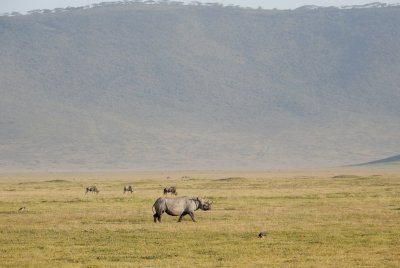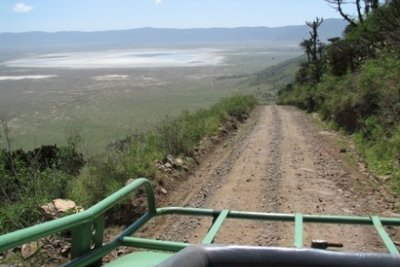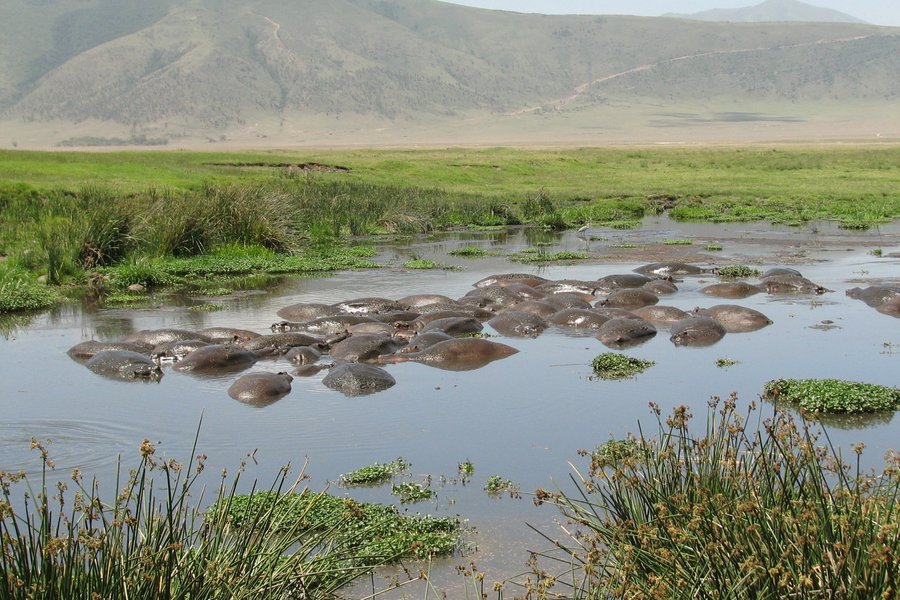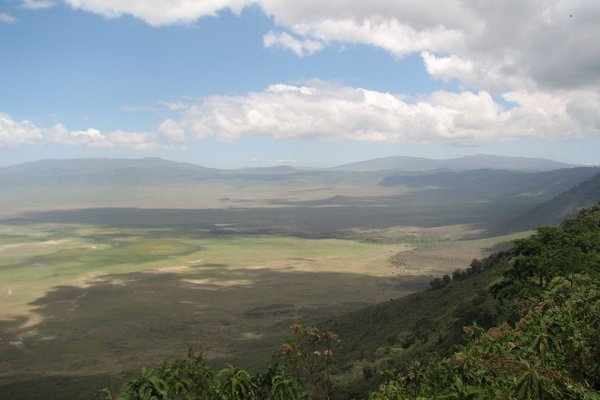Tanzania
Ngorongoro
The Ngorongoro Conservation Area is centered around the Ngorongoro Crater and the hominid fossils found in the Olduvai Gorge.
The crater floor is the world's largest unbroken, unflooded volcanic caldera. Its grassy plains with both fresh and brackish water lakes provide a natural enclosure for a very wide variety of wildlife. Ngorongoro is also part of the annual Serengeti migration route of wildebeest and other ungulates. With Laetoli, where fossilized footprints have been found, and remains of a number of diverse hominin species within the Olduvai Gorge, the site also has contributed to the study of human evolution.
Community Perspective: This covers a large area that extends well beyond the crater into the Lake Ndutu area and Olduvai Gorge; their features are well-described by Squiffy.
Site Info
Official Information
- Full Name
- Ngorongoro Conservation Area (ID: 39)
- Country
- Tanzania
- Status
-
Inscribed 1979
Site history
History of Ngorongoro
- 2010: Extended
- Extension to add cultural criteria: "because of the extraordinary record of human evolution at the site" (including FTWHS Laetoli Site)
- 1989: Removed from Danger list
- 1984: In Danger
- Management shortcomings
- 1979: Inscribed
- Inscribed
- Type
- Mixed
- Criteria
- vii
- viii
- ix
- x
Links
- UNESCO
- whc.unesco.org
- Official
-
- ncaa.go.tz — Ngorongoro Conservation Area Authority
All Links
UNESCO.org
- whc.unesco.org — whc.unesco.org/
Official Website
- ncaa.go.tz — Ngorongoro Conservation Area Authority
News Article
- March 4, 2022 devex.com — Tanzania's Masai fight eviction from UNESCO World Heritage Site
- Jan. 9, 2021 allafrica.com — Finds in Tanzania's Olduvai Gorge Reveal How Ancient Humans Adapted to Change
- Nov. 16, 2017 reuters.com — Light aircraft went down in the Ngorongoro crater and kills 11
- July 16, 2017 theguardian.com — Lioness adopts and nurses leopard cub at Ngorongoro
- May 5, 2009 ippmedia.com — In a move to save the Ngorongoro conservation area from being struck off Unesco`s list of world heritage sites, the government has banned farming inside the area
Community Information
- Community Category
- Paleontology: Human evolution
- Wildlife habitat: Fauna
Travel Information
High entrance fees
Recent Connections
-
Inselbergs
Nasera rock, a spectacular, 50-meter-hi…
-
Perfect Inscriptions
1979 -
Sir Wilfred Thesiger
"In April 1961 Thesiger travelled in Ta…
Connections of Ngorongoro
- Individual People
-
-
Sir Wilfred Thesiger
"In April 1961 Thesiger travelled in Tanganyika (now Tanzania) with another friend, John Newbould, the pair walking for a month around Ngorongoro Crater with donkeys hired from local Maasai. For Thesiger, the Maasai embodied traditional Africa, yet he feared for their future: 'They have scorned everything which the West has offered them, and how right they are. The tragedy is that others who have not... are bound to win in the modern world, though they lose their souls in the process.' SeeSee www.prm.ox.ac.uk
-
Leakey Family
Olduvai in the Ngorongoro conservation area was also famously "discovered" by Mary and Richard. -
Female Archaeologists
Mary Leakey (nee Nicol, 1913-1996) "For much of her career she worked with her husband, Louis Leakey, in the Olduvai Gorge, .... uncovering the tools and fossils of ancient hominenes. Leakey developed a system for classifying the stone tools found at Olduvai" (Wiki)See en.wikipedia.org
-
- Geography
-
-
Crater Lakes
Lake MagadiSee en.wikipedia.org
-
Caldera
Ngorongoro CraterSee en.wikipedia.org
-
Contiguous National Sites
Abuts Serengeti NP
-
- Trivia
-
-
Fatal Accidents or 'disasters'
11 people killed in a plane crash (Nov 2017)
-
- History
-
-
Archaeological 'Type Sites'
Olduvai Gorge - Oldowan Culture ("Even though Olduvai Gorge is the type site, Oldowan tools from here are not the oldest known examples" Wiki)See en.wikipedia.org
-
Early Hominid Remains
Based on fossil evidence found at the Olduvai Gorge, it is known that various hominid species have occupied the area for 3 million years.
-
- Ecology
-
-
African Wild Dog
"Wild dog (Lycaon pictus) have disappeared from the crater and possibly have declined elsewhere in the conservation area" (Nom file) -
Dunes
Shifting Sand Dunes -
Critically endangered fauna species
Black Rhinoceros - General: "Population size collapsed during the last century, from an estimated 65,000 animals in 1970 to a mere 2,300 in the 1990s. Rhino numbers are now increasing, but recovery is slow"; in Nogorongoro: "between 11-14 in 1995" -
Elephants
African elephant -
Inselbergs
Nasera rock, a spectacular, 50-meter-high inselberg
-
Ratites
common ostrich -
Strepsirrhini
brown greater galago -
Fossils
Although the interpretation of many of the assemblages of Olduvai Gorge is still debatable, their extent and density are remarkable. Several of the type fossils in the hominin lineage come from this site. (OUV, crit iv) -
Hippos
"Large mammals in the crater include the .. hippopotamus (Hippopotamus amphibious)."(wiki)See en.wikipedia.org
-
Somalia-Masai regional centre of endemism
-
Flamingos
"Ngorongoro Crater inhabits a considerable population of pink flamingos, with hundreds of thousands of flamingos found in the park" -
Big Five
The 1992 IUCN list of mammals in the AB evaluation includes all 5 (of which buffalo, elephant and leopard were present "on the crater rim" 9but (but still within the inscribed area) whilst Rhino and Lion were "in the crater". As of 2009 it is thought that all are still present, with the Rhino the most threatened. -
Lions
"Studied almost continuously since 1963, it is the best-known, best-studied lion population in the world." and "By April 2022 there are four prides and a total of 45 lions in the Ndutu region (not including visiting groups and nomads)."(see link)See kopelion.org
-
Rhino habitat
Black rhino
-
- World Heritage Process
-
-
Former In Danger List sites
1984-1989
-
Inscribed on all 4 Natural criteria
-
First inscriptions
Tanzania 1979 (as a natural site) -
Mixed sites which became so after original inscription
Natural extended to Cultural -
Extended
2010: Extension to add cultural criteria: because of the extraordinary record of human evolution at the site (including FTWHS Laetoli Site) -
Perfect Inscriptions
1979
-
- Human Activity
-
-
Traditional Hunting
Ritual lion hunting (Ala-mayo) was banned in the 1970s but Masai are allowed to kill lions in retaliation against wildlife attacksSee www.int-res.com
-
Natural sites with indigenous human population
The Masai live in the Ngorongoro Conservation Area and still maintain their pastoralist lifestyle.See www.devex.com
-
Indigenous groups expelled
Maasai. “Perhaps the most critical land loss was experienced by the pastoralists living on the floor of the Ngorongoro Crater. As a consequence of the villagization programme of the mid 1970s and the hardening conservation rule they were evicted from the Ngorongoro Crater in the late 1970s. Grazing and watering of livestock in the Crater, covering an area of some 250 square km, were prohibited - -
Language isolate
Hadza - The Hadza traditionally inhabited the Ngorongoro Crater. They now live in villages around it.
-
- WHS on Other Lists
-
-
WWF Global 200
Terrestrial, Tropical and Subtropical Grasslands, Savannas and Shrublands: (87) East African Acacia Savannas (subregion Serengeti volcanic grasslands)See web.archive.org
-
IUGS Geological Heritage Sites
Palaeoanthropological sites of Human Evolution of Laetoli – Olduvai Gorge & Ngorongoro Crater -
Global Geoparks
Ngorongoro Lengai UNESCO Global Geopark (2018)See www.unesco.org
-
World Biosphere Reserves
Part of Serengeti-Ngorongoro (1981) -
Biodiversity hotspot
Eastern Afromontane -
UNESCO Triple Crown
See www.ncaa.go.tz
-
- Timeline
-
-
Early Pleistocene
Olduvai Gorge gave its name to "Oldowan". This "is the archaeological term used to refer to the stone tool industry that was used by Hominines during the Lower Paleolithic period. The Oldowan is significant for being the earliest stone tool industry in prehistory, being used from 2.6 million years ago up until 1.7 million years ago" (Wiki) Later remains have also been found at Olduvai.
-
- Visiting conditions
-
-
Archaeological Site Reburial
Laetoli Tracks. "The footprints have been Reburied" (2010 AB Eval). In fact the original deliberate reburial of the Tracks by Mary Leakey wasn't a success and has led to improvements in burial technique and subsequent monitoring for such sites.
See www.getty.edu
-
High entrance fees
US$70.80 daily fee per person, plus cost of a vehicle (2024)
-
- Literature & Film
-
-
History of the World in 100 objects
-
In The Simpsons
“Simpson Safari” (2001) -
Blake and Mortimer
The Gondwana Shrine: "In Tanganyika, Professor Heidegang discovers in the lake of the Ngorongoro crater a secret entrance leading to a sort of sanctuary."See en.wikipedia.org
-
News
- devex.com 03/04/2022
- Tanzania's Masai fight eviction fr…
- allafrica.com 01/09/2021
- Finds in Tanzania's Olduvai Gorge …
- reuters.com 11/16/2017
- Light aircraft went down in the Ng…
Recent Visitors
Visitors of Ngorongoro
- Afshin Iranpour
- AK
- Alberto Rodriguez Gutierrez
- alex
- Alex Baranda
- alicemears
- Alikander99
- Ali Zingstra
- A. Mehmet Haksever
- amychemu
- Andrea Szabo
- Angela Vandyck
- arnaugir
- Aspasia
- Atila Ege
- Brett Baumann
- Bropyk
- brornt
- Carlo Medina
- Carlo Sarion
- chapnis
- Christoph
- Crinion
- Csaba Nováczky
- czesioszpachelka
- Dagmara
- dave wood
- Deffra
- Dirk-pieter
- Dolemite92
- DouglasR
- Drk9Stormy
- Elf21
- Els Slots
- Eric Lurio
- Eva Kisgyorgy
- Fan Yibo
- fedemarch92
- Fernweh
- Geert Luiken
- GerhardM
- Gernot
- Grzegorz Andruszkiewicz
- Harald T.
- Harry Mitsidis
- Hdwilsonau
- Iain Jackson
- Ingrid
- IreneKD
- Jacob Otten
- Jana and Matt
- Janos
- Jarrod_Byham
- Javier
- Javier Coro
- jballard650
- Jeanne OGrady
- JJ10
- Joel on the Road
- Jonas Martinsson
- jonathanfr
- Jon Opol
- Joyce van Soest
- JR's HERITAGE SITES
- KarenBMoore
- Kbecq
- KeithBailey
- Little Lauren Travels
- Lucio
- Ludvan
- Luis Filipe Gaspar
- Lukemarshall
- Maja
- Malgorzata Kopczynska
- Marinemajor
- Marlies van Wolfswinkel
- Martin
- maryhattie
- Mathijs
- Matthewrw
- MAURO PODDA PANI
- Michael Ayers
- Michael Novins
- Mikko
- Morodhi
- Mstrebl1990
- Mtlmr
- Nihal Ege
- Nuria8
- PabloNorte
- Paul Schofield
- Peltzi
- petar
- Philipp Leu
- Pieter Dijkshoorn
- Pink Bunny
- Potsdamer
- Priyaranjan Mohapatra
- Rahelka
- Randi Thomsen
- Roman Bruehwiler
- Sandra!
- sbshipway
- Shandos Cleaver
- Shannon O'Donnell
- Sofia84
- Solivagant
- Squiffy
- Squire Sullen
- Sturuss
- Sutul
- Svein Elias
- Szucs Tamas
- Thomas Buechler
- Tim Allen
- Timothy C Easton
- Toxicologist
- triathlete_16
- Vanessa Buechler
- voyager
- Waxwing
- Wojciech Fedoruk
- Wo_ko
- ZCTLife
- zfish
- Zizmondka
- Zoë Sheng
- Zsuzsanna Forray
Community Reviews
Show full reviews
The giraffes stared down at us. We stared up at them. Animals that had seemed gentle and almost comic from a vehicle were much more imposing when viewed from on foot. One became agitated by our presence so we retreated back to the cover of the trees lining the gorge. “Take care”, urged Taletien, suggesting we grasp the tough sisal leaves – oldupai in Maasai – as support ropes while we descended the riverbank. But as I jumped the last foot down to the fine black sand I caught the edge of my palm on a leaf tip. Blood welled up. Taletien inspected the prick: “Let me show you some Maasai medicine”. With his knife he chopped down an oldupai leaf. He twisted it so that its greenish soapy-smelling liquid dripped onto the cut. This, he explained, was a local (in both senses of the word) anaesthetic. But he still recommended a wash and a plaster once we left the gorge.
The gorge in question was, of course, Olduvai (or Oldupai) Gorge, one of the most famous paleoarchaeological sites in the world. Unlike Louis and Mary Leakey we were not searching for the remains of Pleistocene hominids; we were merely taking a breather between the two big finales of our safari, the Serengeti and Ngorongoro Crater. But we were already in the World Heritage Site: the Ngorongoro Conservation Area extends far beyond the crater itself. In the north-west it abuts the Serengeti National Park itself, then stretches …
Keep reading 0 comments
Ngoro Ngoro is the sound cowbells make. At least this is one of the possible origins of the name Ngorongoro. These bells you hear right away when descending the 600 meters from the crater rim. Some Maasai herdsmen are leading their herds down for water. These herds consist of dozens if not hundreds of cows.
On the crater floor, we encounter only birds at first, such as cranes and the sacred ibis. The major salt lake also holds numerous flamingos. Unfortunately, you cannot come close, but a pink glow can be seen. Not far away is a mud bath full of hippos. These are more lively than the ones we saw in the Serengeti. They perform a full circle of 360 degrees with their fat bodies, so they get completely covered by the mud.
On a plain, our driver suddenly spots a rhinoceros. There are only 22 of them in the crater, so it's a rare appearance. He is moving among a group of wildebeest and buffaloes. With this (black) rhino, we have completed seeing the "Big Five" of predators in two days (lion, elephant, buffalo, leopard, rhinoceros).
Another highlight comes from a family of hyena just along the road. We first see a male and a pregnant female hurrying in front of our jeep. A little further it shows that they were on their way to their little ones, which are half-hidden in a pit. There are three kids in all. The whole family then huddles …
Keep reading 0 comments
Returned to Canada from a great tour. Enjoyed our time at the crater very much. Had excellent guides/drivers with Leopard Tours, stayed at Serena Lodges and enjoyed them all very much. The Serenena Lodge at the Crater being one of my favourite. Food excellent, staff wonderful. Room very comfortable, enjoyed the cooler evening for sleeping. Saw an amazing rainbow late afternoon over the crater out my door - great photo. Saw lions, rhino, huge elephant lots of other animals also. Would have liked to see more rhino, but at least saw the one. Great day, would like to explore area surrounding crater more - next time! Enjoyed seeing the Maasai with their herds, missed them when we got to the Serengeti. Was not overly impressed with Olduvi Gorge, but it was OK.
Keep reading 0 comments
I recently visited Tanzania on safari for my honeymoon. We visited in early July and spent almost two weeks there. On our travels we visited the Ngorongoro Conservation Area. It was amazing. Although we were there during the dry season and everything wasn't as lush as in pictures I had seen, it was beautiful. The weather was cool to cold along the rim, but inside the crater it was perfect weather for safari. Because of it being the dry season the tsetse flies were minimal and mosquitos were not a problem. We saw lions, hyenas, black-backed and common jackals, elephants, DeFassa's waterbuck, vervet monkeys, baboons, plenty of hippos, wildebeast, zebra, Thomson and Grant gazelle, flamingo, three species of eagles, various water birds, buffalo, and four black rhino. Amazing!! A lifetime experience for naturalists. A nice note is that the crater closes at 6 pm daily and this is strictly enforced. Park rangers watch your every move from above. The needs of the animals are definitely the priority here.
Keep reading 0 comments
